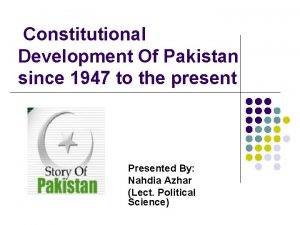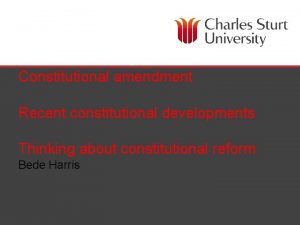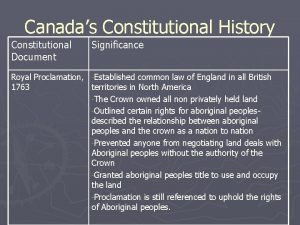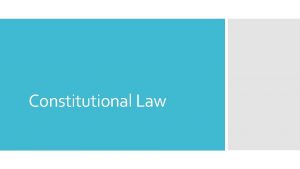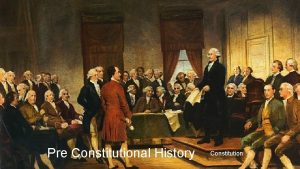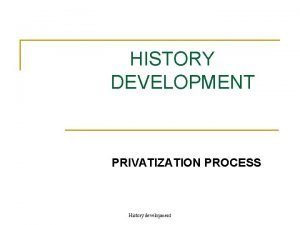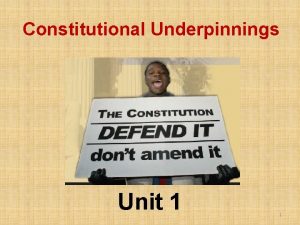CONSTITUTIONAL DEVELOPMENT INTRODUCTION The history of constitutional development














- Slides: 14

CONSTITUTIONAL DEVELOPMENT INTRODUCTION ØThe history of constitutional development is history of raving ambitious and insidious plots hatched by Britishers. ØAlthough, it led to the ultimate accomplishment of Indian constitution.

Ø Ø Ø Ø Regulating Act of 1773 Pitt’s India Act of 1784 Charter Act of 1813 Charter Act of 1833 Charter Act 1853 The Act of 1858 Act of 1861 Act of 1892

THE INDIAN COUNCILS ACT, 1909 OR MINTO MORLEY REFORMS Circumstances leading to the passing of the Act Ø 1. one of the major reasons which led to the enactment of the Minto-Morley Reforms Act was dissatisfaction of the Indians with the Indian Councils Act, 1892. Ø As already noted above, the Indians were greatly disappointed with the Act of 1892 because it did not give enough powers to the Legislative Councils.

Ø Ø Ø The members were not given any effective power to discuss the budget or ask questions. The strength of the elected members was also highly inadequate. Therefore, the Indians under the Indian National Congress started agitation for more reforms and the government responded by the enactment of the Indian Councils Act 1909.

The natural calamities during the years 1899 -1900 and the enormous suffering caused to the inadequate measures taken by the government. Two famines 1896 -97 plague of 1898. Lord Curzon 1904 Indian Universities Act 1905 Partition of Bengal.

PROVISIONS OF THE ACT The Indian Councils Act of 1909 was an improvement over the Indian Councils Act of 1892 in many ways. It not only increased the strength and powers of the Legislative Councils but also associated the Indians with legislative work as well as the administration of the country.

In addition it also introduced the system of separate electorates and an indirect election. MAIN PROVISIONS The size of the Central Legislature and provincial legislature was enlarged. The number of additional members in the Viceroy’s executive council was raised from 16 to 60. The Legislative councils of Bengal, Bombay and Madras was increased to 50 members each. Enlargement of function of legislative councils. Increase in number of members of executive councils of provinces. Restricted and discriminatory franchise.

Appointment of Indians to Executive councils. Introduction of Communal and class electorates. This act was given the communal and class representation, which left a deep impact on the course of Indian history.

MONTAGAUE- CHELMSFORD REFORMS OF 1919 PROVISIONS OF THE ACT: Ø The act clearly defined its objective in the preamble which was attached to it. Ø The preamble read “Whereas it is the declared policy of the parliament to provide for the increasing association of Indians in every branch of Indian administration, and for gradual development of selfgoverning institutions. Ø Changes in Home Government: Ø The act introduced a number of changes in the Home Government.

High Commissioner of India, a new office created under the Act. High Commissioner was to be appointed by the Government of Indian and paid out of Indian revenues. CHANGES AT THE CENTRE Ø In India at the Central level the Act introduced important changes both in the executive and legislative spheres. Ø The number were Indians in the Governor. General’s Executive Council was raised to three out of 8. Ø The Indian members were entrusted with the administration of departments like law, education, labour, health etc. However, this arrangements was highly unsatisfactory.

CHANGES AT PROVINCIAL LEVEL: Ø It introduced important changes in provincial sphere. Ø Accordingly, the Act of 1919 introduced the system of dyarchy in the provinces. Ø This system was introduced in the provinces of Bengal, Bihar, Assam, , Madras, Bombay, punjab, U. P. Subsequently it was extended to the North-West Frontier Province in 1932. Ø This system remained in operation till 1937. Ø Under the system of dyarchy the provincial subjects were divided into two part a) Reserved – Kept under the control of Governor with the help of Executive Council. b) Transferred- Kept under the control of Governor with the help of ministers.

The size of the Provincial Legislature (Legislative Council) was also considerably increased, although their strength varied from province to province. The functions of the Provincial Legislatures (Legislative Councils) were also enlarged.

THE GOVERNMENT OF INDIA ACT, 1935 INDIAN INDEPENDENCE ACT 1947: Ø On 4 July, 1947, the British Government introduced the Indian Independence Bill in the House of Commons. Ø The bill was passed by both the Houses of British Parliament within a short span of a fortnight. PROVISIONS OF THE ACT Ø It provided for the division of India into two Dominions India and Pakistan with effect from 15 August 1947. Ø The British Government was to transfer all the power to the Constituent Assemblies of the two Dominions, which would be free to prepare any Constitution for their respective states.

Until a new Constitution was framed by each Dominion all the provinces were to be administered in accordance with the provisions of Government of India Act, 1935. The Act provided that each Dominion could have a Governor-General, to be appointed by the British King on the advice of the Cabinet of the concerned Dominion. The Governor-General and Governors of the Provinces were expected to act on the advice of the ministers in all matters, including those where they
 Constitutional development in pakistan from 1947 to 1973
Constitutional development in pakistan from 1947 to 1973 Hát kết hợp bộ gõ cơ thể
Hát kết hợp bộ gõ cơ thể Lp html
Lp html Bổ thể
Bổ thể Tỉ lệ cơ thể trẻ em
Tỉ lệ cơ thể trẻ em Chó sói
Chó sói Tư thế worm breton là gì
Tư thế worm breton là gì Hát lên người ơi alleluia
Hát lên người ơi alleluia Kể tên các môn thể thao
Kể tên các môn thể thao Thế nào là hệ số cao nhất
Thế nào là hệ số cao nhất Các châu lục và đại dương trên thế giới
Các châu lục và đại dương trên thế giới Công của trọng lực
Công của trọng lực Trời xanh đây là của chúng ta thể thơ
Trời xanh đây là của chúng ta thể thơ Cách giải mật thư tọa độ
Cách giải mật thư tọa độ Phép trừ bù
Phép trừ bù
